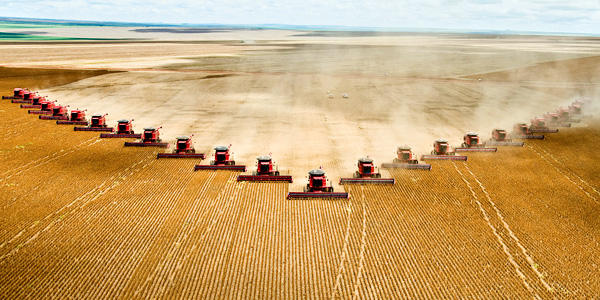The Blogging Farmer
Alex Tiller’s Blog on Agriculture and Farming
Where U.S. Agricultural Policy Goes from Here
The agricultural resources of the United States, while the most productive of any in the world, have been severely harmed by government policies. A commodity-based industrial system has encouraged overproduction, lowering prices and making it difficult for farmers to survive without government assistance. Meanwhile, erosion and water pollution have exacerbated the man-made problems facing the farming industry. It is clear that something needs to be done at the national level, if turning the U.S. agricultural base into a sustainable industry is still possible.
Current U.S. agricultural policy has evolved over the time from the colonial era, to the Revolutionary War, to the Industrial Revolution and beyond. Resource overproduction and land exploitation were always at the top of the list, and as technology progressed in the 20th century, new and more efficient ways of doing so were devised. The trade policies of other countries around the world, often modeled around our own, and the nature of worldwide trade all have led to low prices in an already unsustainable agriculture.
The questions are what is to be done about the situation and what path does U.S. agricultural policy go from this point? The corporate nature of agriculture and farming feeds the practice of overproduction with the aim to increase profits, while the earnings farmers receive for their product continues on a decline. A 1996 farm bill which aimed to control production and set prices based on market conditions failed, while a 2000 bill ensured government money to farmers. Subsidy payments were set to new highs by a 2002 farm bill, without any policies to manage production.
A program to encourage conservation by farmers was included in the 2002 bill. This Conservation Security Program was designed to help improve the environment, and offer financial rewards to farmers who make conservational efforts. Congress placed a ten year cap on the funding for this program. Little would be accomplished if additional funding wasn't put in place, and the program was accompanied by policies that contradict its intent. Continuation of the program would keep subsidies going to farmers, but at least the general public could benefit from the cleaner environment resulting from more sustainable practices.
Trade policies need to also follow the regulations of the World Trade Organization, which require that subsidies do not influence how commodities are traded. Since environmental concerns are expressed worldwide, the Conservation Security Program is looked upon favorably. In instances where watersheds are polluted, the problem can be addressed by seeking out the source and helping farmers to fund pollution control measures. The initiative was further boosted by the Conservation Stewardship Program in 2008, meaning that this could prove to be a viable path for U.S. agricultural policy in the coming years.
The best incentives may be financial, but support of organic farming and ways to reduce the flow of pollution and prevent erosion will address the major environmental impacts.
Perhaps the most efficient direction to follow, and where U.S. agricultural policy may be heading towards, is to directly address practices that aid in environmental conservation. The best incentives may be financial, but support of organic farming and ways to reduce the flow of pollution and prevent erosion will address the major environmental impacts. Methods such as longer crop rotations and mixing of crops that do not deplete resources as quickly should be encouraged as well. The best way to enforce sustainable practices is to create incentives for farmers to follow them, and financial rewards at a time when cash resources are short hold promise. This could only be accomplished at the national policy level. It may already be that the future structure of U.S. agricultural policy is in its formative stages as programs initiated over the past decade build momentum.
Source and Further Reading:
The Minnesota Project: A New Agricultural Policy for the United States
The Minnesota Project--Agriculture & Water: Conservation Stewardship Program
Hello, and thanks for checking out my blog. My name is Alex Tiller and I grew up in rural Ohio (Clark County) where my family still owns farmland (corn and beans). I am a member of the American Society of Farm Managers and Rural Appraisers and am also an agribusiness author/blogger. I write about commercial farming, family farms, organic food production, sustainable agriculture, the local food movement, alternative renewable energy, hydroponics, agribusiness, farm entrepreneurship, and farm economics and farm policy. I visit lots of farms in different areas of the country (sometimes the world) that grow all kinds of different crops and share what I learn with you through this blog.? You can contact me via email by clicking here: Email Alex
Founder/Publisher/Editor: David McGee
Contributing Editors: Billy Altman, Laura Fissinger, Christopher Hill, Derk Richardson
Logo Design: John Mendelsohn (www.johnmendelsohn.com)
Website Design: Kieran McGee (www.kieranmcgee.com)
Staff Photographers: Audrey Harrod (Louisville, KY; www.flickr.com/audreyharrod), Alicia Zappier (New York)
E-mail: thebluegrassspecial@gmail.com
Mailing Address: David McGee, 201 W. 85 St.—5B, New York, NY 10024



